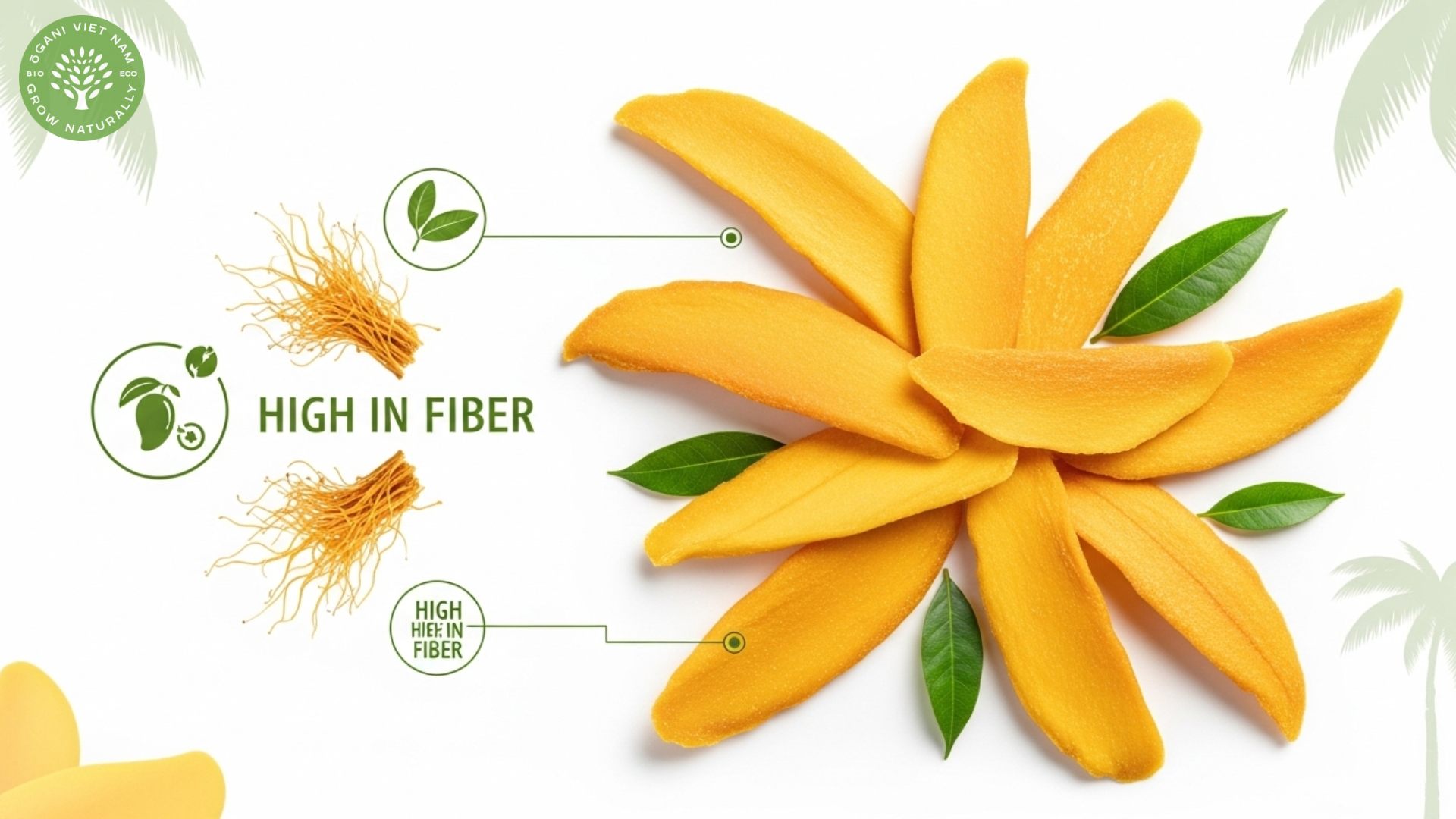The fiber in dried mango packs a decent punch, with around 2-4 grams per 100 grams depending on the variety and processing. This fiber helps with digestion, keeps you feeling full, and supports overall gut health, making it a smart snack choice for those watching their fiber intake.
At Ogani VN, we’ve been sourcing premium mangoes from lush Vietnamese orchards for years, and let me tell you, nothing beats that natural sweetness combined with a fiber boost that keeps things moving smoothly.
Nutritional profile of dried mango
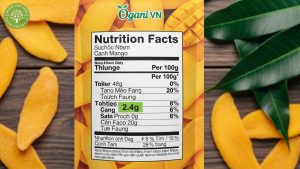
When you grab a handful of dried mango, you’re not just getting a tasty treat; you’re loading up on essential nutrients, including that all-important fiber. A typical 100-gram serving delivers about 314 calories, mostly from carbs, with protein and fat playing smaller roles. But the star here is the fiber in dried mango, which clocks in at roughly 2.4 grams, helping to regulate your digestive system without the bulk of fresh fruit.
We’ve crafted our Ogani VN dried mango to retain as much natural goodness as possible, skipping unnecessary additives. It’s low in fat, rich in vitamins like A and C, and offers minerals such as potassium and iron that complement the fiber for better health.
Here’s a quick breakdown of key nutrients in 100 grams of dried mango:
| Nutrient | Amount | % Daily Value |
|---|---|---|
| Calories | 314 | – |
| Carbohydrates | 78.6 g | 29% |
| Fiber | 2.4 g | 9% |
| Sugar | 66.3 g | – |
| Protein | 2.45 g | 5% |
| Vitamin C | 42.3 mg | 47% |
| Potassium | 279 mg | 6% |
This table shows how fiber in dried mango fits into the bigger picture, providing a concentrated source of energy and nutrients.
Types of fiber in dried mango
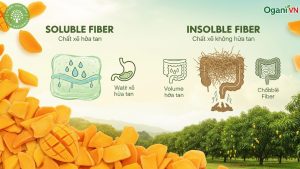
Dried mango contains both soluble and insoluble fiber, each playing a unique role in your body. Soluble fiber dissolves in water to form a gel-like substance, while insoluble adds bulk to stool. Together, they make fiber in dried mango a powerhouse for digestive health.
At Ogani VN, our drying process preserves these fibers naturally, ensuring you get the full benefits in every chewy bite. I recall munching on these during a long hike in the Vietnamese highlands – kept me energized without any tummy troubles.
Dried mango’s fiber mix helps stabilize blood sugar and promotes regularity, but portions matter to avoid overdoing the natural sugars.
Soluble fiber
Soluble fiber in dried mango helps lower cholesterol and control blood sugar levels by slowing digestion. It’s particularly useful for those with diabetes or heart concerns, as it binds to bile acids and escorts them out.
Insoluble fiber
Insoluble fiber bulks up your stool and speeds up transit time in the gut, preventing constipation. This type dominates in the skin and pulp remnants of dried mango, making it a natural laxative in moderation.
Health benefits of fiber in dried mango
The fiber in dried mango isn’t just filler; it actively supports your health in multiple ways. It promotes satiety, helping you feel full longer, which can aid in weight management. Plus, it feeds good gut bacteria, boosting your microbiome.
From our experience at Ogani VN, customers often share how adding our dried mango to their routine improved their daily fiber intake effortlessly. One time, a friend confessed it helped curb her afternoon snack cravings – small wins like that make all the difference.
Studies show that fiber-rich foods like this can reduce chronic disease risks, including diabetes and heart issues. But remember, balance is key; pair it with water for best results.
Here are some key benefits:
- Digestion support: Prevents constipation and promotes regular bowel movements.
- Blood sugar control: Slows sugar absorption, stabilizing levels.
- Heart health: Lowers cholesterol by binding to it in the gut.
- Weight management: Increases fullness, reducing overall calorie intake.
- Antioxidant boost: Works with vitamins to fight inflammation.
Fiber-rich snacks like dried mango can transform your diet – one study found it enhances satiety more effectively than low-fiber options.
Comparison: dried vs fresh mango
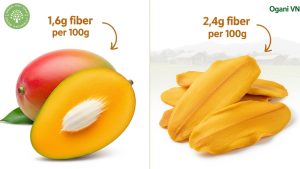
Dried mango concentrates nutrients due to water removal, so per 100 grams, it often has more fiber than fresh – 2.4 grams versus 1.6 grams. However, fresh mango offers more per calorie because of its lower density, with better satiety effects from higher moisture and fiber combo.
We at Ogani VN love both, but dried is perfect for on-the-go. Fresh feels refreshing, like biting into a ripe fruit under the tropical sun, while dried packs that punch in a portable form.
When comparing, consider portion sizes; dried’s higher sugar can add up quickly if you’re not mindful.
| Aspect | Fresh Mango (100g) | Dried Mango (100g) |
|---|---|---|
| Fiber | 1.6 g | 2.4 g |
| Calories | 60 | 314 |
| Vitamin C | 36.4 mg | 42.3 mg |
| Sugar | 13.7 g | 66.3 g |
| Water | 83.5 g | 16.6 g |
This table highlights how drying intensifies flavors and nutrients, but also calories – choose based on your needs.
Fiber content per serving
Per equal weight, dried wins on fiber, but fresh provides more volume for fewer calories.
Impact on satiety and glucose
A study revealed fresh mango’s higher fiber per calorie leads to better fullness and stable blood sugar compared to dried. Dried still beats processed snacks, though.
Nutritional trade-offs
Dried retains more vitamins in some cases, but loses some heat-sensitive ones like beta carotene.
How to incorporate dried mango into your diet
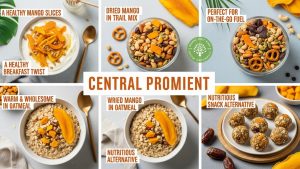
Adding dried mango to your meals is simple and versatile. Start with a small handful as a snack, or chop it into salads for a sweet twist. The fiber in dried mango makes it ideal for boosting smoothies or yogurt without extra prep.
At Ogani VN, we suggest trying it in trail mix – mixes well with nuts for a balanced bite. I’ve tossed some into my morning oatmeal, and it turns a bland bowl into something exciting, with that fiber keeping me satisfied till lunch.
Watch portions to manage sugar; aim for 30-40 grams daily. Store in a cool, dry place to keep it fresh.
- Mix into granola or cereal for breakfast fiber kick.
- Add to baked goods like muffins for natural sweetness.
- Pair with cheese or nuts for a savory-sweet appetizer.
- Blend into energy balls for post-workout fuel.
Frequently Asked Questions
Here, we address some common questions about fiber in dried mango based on what our Ogani VN customers often ask.
How much fiber is in a serving of dried mango?
A 40-gram serving typically has 1-2 grams of fiber, varying by brand. Our Ogani VN version aims for the higher end with minimal processing.
Is dried mango better than fresh for fiber?
Per weight, yes, but fresh might be superior per calorie for satiety.
Can too much dried mango cause digestive issues?
Yes, excessive fiber can lead to bloating; start slow and drink plenty of water.
Does Ogani VN add sugar to dried mango?
No, we keep it natural and unsweetened to highlight the pure mango flavor.
Where can I buy Ogani VN dried mango?
Visit our website or local stores in Vietnam for authentic products.
Wrapping up
In summary, the fiber in dried mango offers valuable benefits like improved digestion, better blood sugar control, and enhanced satiety, all while providing a delicious, convenient snack. Whether you’re comparing it to fresh or exploring its nutritional depth, it’s a worthy addition to any diet.
At Ogani VN, we’re passionate about bringing you the best from Vietnam’s mango groves. Ready to boost your fiber intake? Head to our site today to order some premium dried mango and experience the difference yourself – your gut will thank you! Contact us for any questions or bulk orders.
Read more:
- Dried Mango Nutrition Facts: Complete Guide To Calories, Benefits & Health Impact
- Best Dried Mango No Sugar Added: Premium Quality Guide
- Calories In Dried Mango No Sugar Added: Complete Nutrition Guide
- Dried Mango Nutritional Value: Complete Health Guide
- Fiber In Dried Mango: Nutrition, Benefits, And Tips


